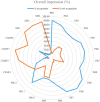Fortification of cocoa semi-skimmed milk formulations with native lactic acid bacteria: Cell viability, physicochemical and functional properties for developing novel foods
- PMID: 36313091
- PMCID: PMC9608143
- DOI: 10.3389/fnut.2022.1008871
Fortification of cocoa semi-skimmed milk formulations with native lactic acid bacteria: Cell viability, physicochemical and functional properties for developing novel foods
Abstract
This study aimed to evaluate several cocoa semi-skimmed milk formulations (CSMFs) as potential carriers of native lactic acid bacteria (LAB) strains to obtain novel probiotic beverages (PBs) with improved technological and functional characteristics, and satisfactorily organoleptic acceptance. The viability of two native LAB (Lactiplantibacillus plantarum UTNGt2 and Lactiplantibacillus pentosus UTNGt5) was assessed in comparison with two references (Lactococcus lactis subsp. lactis ATCC11474 and Limosilactobacillus reuteri DSM17938) strains in supplemented CSMFs throughout storage with refrigeration. The optimum conditions to produce novel beverages supplemented with native LAB were pH 6.6, 42°C, and 1 h of fermentation. Moreover, the effect of LAB strains fortification on pH, titratable acidity, total solids (°Brix), total polyphenolic compounds (TPC), antioxidant capacity (AOX), and ascorbic acid content (AAC), total proteins and fat, at initial and final storage was evaluated. The addition of two native LAB strains did alter the physicochemical quality of CSMFs to a lesser extent, where the bioactive molecules improved significantly (p < 0.05) with the increase of cocoa concentration and depending on the supplied strain. Although a statistically significant (p < 0.05) decrease in cell counts was recorded during storage, the LAB cells were found to be viable up to 21 days of storage at 4°C (>6 logCFU/ml), which is sufficient in number to prove their stability in vitro. Overall organoleptic results suggested that LAB supplementation had a significant impact on sensory attributes with satisfactory acceptability (>78%) of PBs containing the native strains and 1-2% cocoa, while CSMFs counterparts were less appreciated (40%) as perceived off-flavor. It appears that supplying bacteria to CSMF preserves flavor in the final product. Furthermore, the final beverages were free of harmful bacteria; thus, they comply with consumer safety regulations. This study concludes that CSMF can be used as a carrier of native LAB strains, maintaining cell viability, unaltered physicochemical properties, and improved functional and sensory characteristics, for which final beverages can be regarded as functional food. From the application standpoint, these formulations are an alternative to delivering native LAB strains and could help the cocoa and dairy industry to develop more attractive products for the growing regional market.
Keywords: antioxidant activity; cocoa; lactic acid bacteria; polyphenols; probiotics.
Copyright © 2022 Tenea and Ascanta.
Conflict of interest statement
The authors declare that the research was conducted in the absence of any commercial or financial relationships that could be construed as a potential conflict of interest.
Figures








References
-
- Gómez-Fernández AR, Faccinetto-Beltrán P, Orozco-Sánchez NE, Pérez-Carrillo E, Marín-Obispo LM, Hernández-Brenes C, et al. Sugar-free milk chocolate as a carrier of omega-3 polyunsaturated fatty acids and probiotics: a potential functional food for the diabetic population. Foods. (2021) 10:1866. 10.3390/foods10081866 - DOI - PMC - PubMed
-
- Sohag MSU, Paul M, Al-Bari MAA, Wahed MII, Khan MRI. Potential antidiabetic activities of probiotic strains, L. acidophilus and L. bulgaricus against fructose-fed hyperglycemic rats. Food Nutr Sci. (2019) 10:1419–32. 10.4236/fns.2019.1012101 - DOI
LinkOut - more resources
Full Text Sources
Miscellaneous

